
Tony Keswick, a local Laird, was a good friend of the famous Henry Moore and it was through their influences that the world famous statues were placed amongst these most picturesque hills and glens of Glenkiln in Irongray Parish. To visit, take the A75 from Dumfries to Stranraer and in 6 miles west of Dumfries, turn right for the village of Shawhead. In a mile turn right in the village then keep left and in about 2 miles up a narrow country tar-surfaced road you will come to the King and Queen statue on the left and Glenkilns Reservoir on your right. There is a car parking area at the top of the reservoir beside the statue of John the Baptist. Thereafter proceed on foot to the various locations. You can pick up a brochure at the local Tourist Office to show the location of various statues within the area.
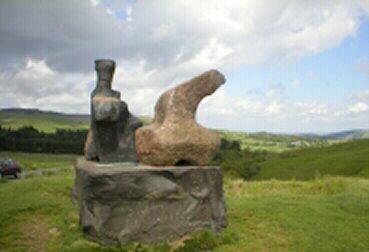
TWO PIECE RECLINING FIGURE
This statue described as a 'Two Piece Reclining Figure" was by Henry Moore in 1959. The particular sculpture is a mixture of the human figure and landscape, a metaphor of the relationship of humanity with the earth just as a poem can be. Although the statues itself is of Fibre Glass, the local stone base weighs 10 ton and the statue is 6 feet 4 inches long. If you ever get the chance to see this wonderful piece of sculpture consider not just the two pieces but the space between.
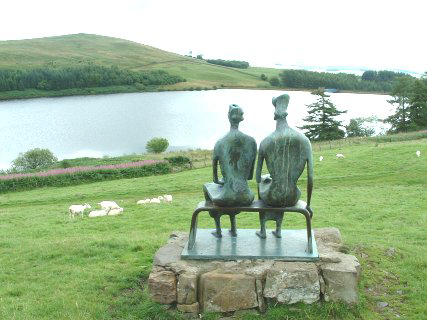
KING AND QUEEN
Original was in Antwerp, Belgium and the sculpture originated not from a drawing but from playing around with modeling wax. It was started with the 'Kings' head then because it looked like a King required a Queen to go with it. Sculpture was by Henry Moore in 1952-53. It is considered that this was one of the best of Moor's work. The statue now commands an attractive location above the Glenkilns reservoir which supplies water to the nearby town of Dumfries.
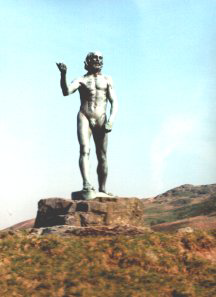
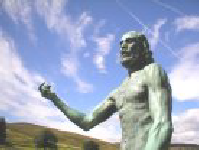
JOHN THE BAPTIST
Henry Moore opinioned that Auguste RODIN (1878-80) was perhaps the greatest at sculpting the human body. The sculpture of John the Baptist (above and right) was probably one of Rodins' earliest works. Rodin seemed best able to understand the human figure, and as a result produced many very important works.
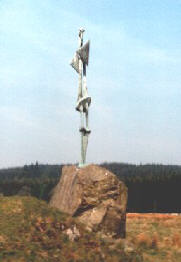
STANDING FIGURE
This is a bronze statue by Henry Moore in 1950 and stands 7'3" tall. It was the first of the Glenkilns statues and was the influence that created and later cemented the relationship between Tony Keswick and Henry Moore. Moore's statue in 1950 was originally next to the house Hoglands in Penny Green, London. It is located approximately 400 metres along the road beside the stone bridge beyond the statue of John the Baptist. Don’t miss this one if visiting.
VISITATION - JACOB EPSTEIN 1926
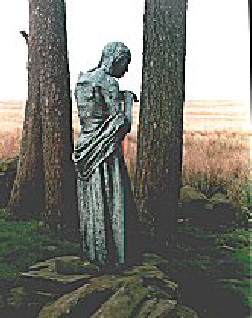
"And Mary arose in Those days, and went into the hill country with haste, into the city of Juda; And entered into the house of Zacharias and saluted Elizabeth. And it came to pass, that, when Elizabeth heard the salutation of Mary, the baby leaped in her womb, and Elizabeth was filled with the Holy Ghost. And she spake out with a loud voice, and said, Blessed art thou amongst women, and blessed is the fruit of the womb. And whence is this to me, that the mother of the Lord should come to me? For, lo, as soon as the voice of the salutation sounded in my ears, the babe leaped in my womb for joy. And blessed is she that believed; for there shall be a performance of those things which were told her from the Lord" - Luke 1. verses 39-45.
Epstein depicts the Virgin Mary in the moment that she is recognized as the mother of God by her cousin Elizabeth. The child in Elizabeth's womb was John the Baptist whose conception like that of Jesus was announced by the angel Gabriel. The statue, in the centre of a copse of trees, is 6'6" high and is made of bronze.
TONY AND MARY KESWICK MEMORIAL On a trip to Istanbul in the 1970's Tony Keswick was much taken with the 'widows stones' he saw in cemeteries there. Apparently, the 'turban' topped stones were traditional entitlement of the widow in Turkey, a tradition which still holds good today. He decided that he would like one as a Memorial stone for himself and Mary Keswick at Glenkiln. He made the necessary arrangement with Sir James Bowher (British Ambassador to Turkey). After great difficulty he managed to have a stone shipped to Scotland






